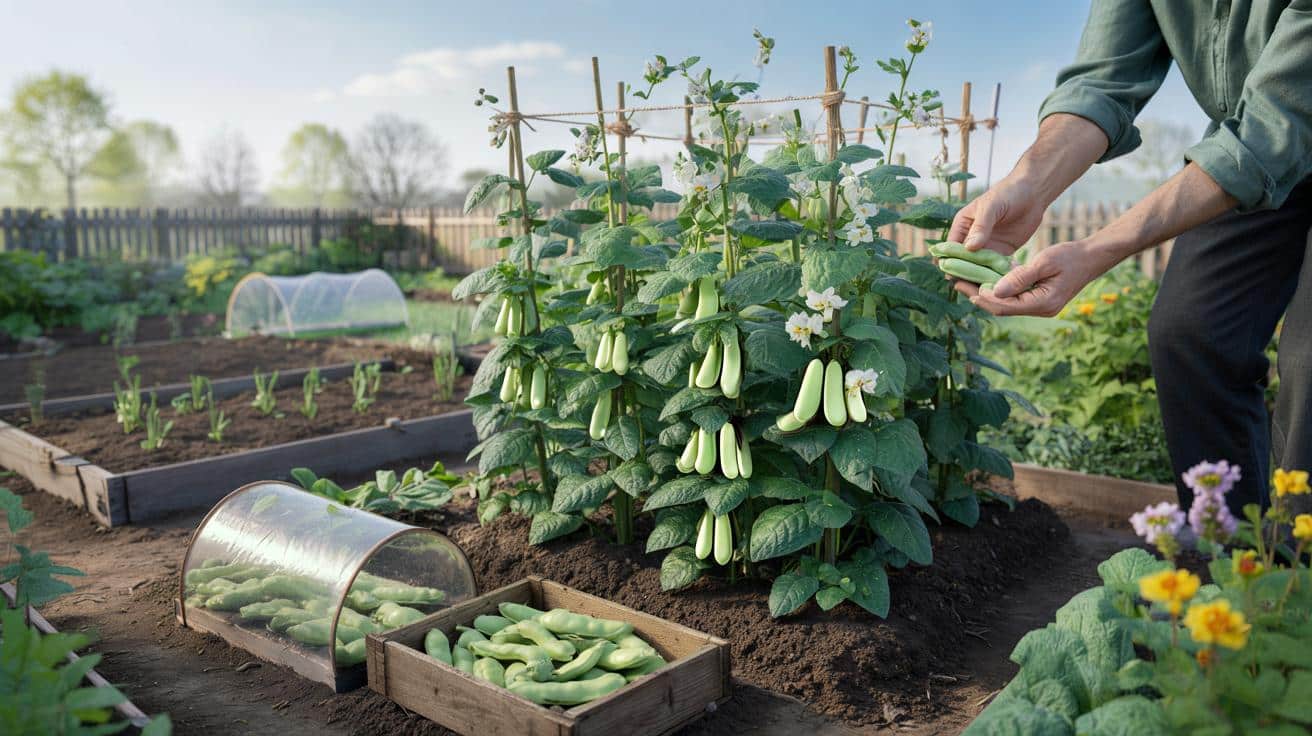Across mild regions, a neglected autumn sowing is setting up nimble growers for a spring head start. It draws on winter rains, shrugs off short days and then bursts forward as light returns. The result is speed on the plate, less pressure in late spring, and a soil that starts summer stronger.
Meet the broad bean, your spring head start
A humble legume with generous habits
Broad beans, cousins of peas and French beans, rarely grab attention. They deserve it. The plants anchor nitrogen in the soil through symbiotic bacteria, enriching beds for later crops without resorting to synthetic fertiliser. Pods picked young taste sweet and tender, while older beans puree into silky dips and soups.
Sow broad beans in autumn and you’re banking nitrogen for summer crops while bringing dinner forward by weeks.
Why most people miss the autumn window
Many gardeners wait for spring, fearing frost or assuming beans hate cold. Hardy varieties handle typical maritime winters. Sown now, they root quietly, then power into growth as days lengthen. That head start beats spring sowings by four to six weeks, often yielding in April or early May when others are still hardening off plants.
How to sow for speed from late October
Soil, spacing and varieties that pay off
Choose a free-draining, fertile bed in full sun, sheltered from northerly winds. Fork in well-rotted compost. Avoid waterlogged clay; if you must use it, raise the bed and add coarse grit to improve drainage.
- Timing: late October to mid-November in mild and coastal areas; wait until spring in colder inland or high-altitude zones.
- Rows: space 40 cm apart for airflow and light.
- Seeds: set every 15–20 cm, 5 cm deep, eye downward, then firm gently.
- Water: moisten at sowing only; winter weather usually does the rest.
- Protection: fleece or a light mulch if a sharp frost is forecast after emergence.
Pick hardy, fast varieties. Aquadulce longpod (also sold as Aquadulce Claudia) performs reliably in winter. ‘Express’ is bred for speed, bringing earlier pods on compact plants. Both suit tight spaces and allotments alike.
Row spacing 40 cm; seeds 15–20 cm apart and 5 cm deep. Keep soil open, rich and free-draining for a uniform stand.
Where autumn sowing excels
Mild Atlantic and Channel coasts, south-western corridors and urban microclimates tend to succeed without fuss. Colder interiors risk winterkill in harsh snaps below –8°C without cover. Where winters bite, shift to a late February or March sowing under cloches, then follow with a second sowing three weeks later for continuity.
| Climate band | Autumn sowing? | Simple protection | Typical harvest |
|---|---|---|---|
| Mild coastal (Atlantic, Channel, south-west) | Late Oct–mid Nov | Fleece in hard frost; mulch for drainage | Mid April–May |
| Inland temperate (lowlands, large towns) | Late Oct if settled; or Feb–Mar | Cloches if nights dip below –5°C | Late April–June |
| Cold continental or upland | Prefer Feb–Apr | Windbreak and mulch | May–June |
Beating your street to pods: what the calendar really looks like
From winter roots to spring flowers
October sowings germinate in the lingering warmth, then sit low and sturdy through winter. As day length rises from February, growth surges. Buds form early, and flowers set before spring winds dry the soil. Expect the first pickings as soon as pods feel full yet still tender, often by mid-April in milder spots.
This rhythm eases the spring bottleneck. You are harvesting protein while neighbours are still sowing, and your beds clear in time for early summer crops like courgettes, tomatoes or sweetcorn.
Handled well, autumn-sown broad beans yield 2–3 kg per square metre and free the bed by early June.
Pitfalls to avoid when winter does its worst
Cold snaps, wet feet and wind
Severe freezes can scorch soft growth. Choose a sunny, sheltered position and avoid valley frost pockets. More plants fail from waterlogging than cold: excess winter rain starves roots of oxygen and invites rot. On heavy soils, sow on ridges or raised beds to keep crowns high and dry. In windy gardens, run rows along a low windbreak or string plants between stakes.
Pests and diseases that show up early
Black bean aphid loves soft tips in spring. Pinch out the top 5 cm once the first pods set; it reduces sap-rich growth that attracts colonies and redirects energy into pods. Companion plants such as mint or French marigolds can confuse pests and draw beneficial insects. Keep an eye out for chocolate spot in damp spells; wider spacing, morning sun and debris-free soil limit its spread.
Water and feeding without fuss
Broad beans hate drought at flowering. Keep moisture steady as buds appear and during pod fill. A mulch of leafmould or compost in late winter smooths swings in soil moisture and feeds soil life. Skip high-nitrogen feeds; foliage will balloon at the expense of pods. A potash-leaning organic fertiliser, if any, is sufficient on lean beds.
Harvesting, kitchen wins and what to sow next
Picking for taste and yield
Start early. Young pods, 10–12 cm long, give sweet, green beans that barely need cooking. As pods swell, flavour deepens and skins toughen; peel the grey outer skin after a brief blanch for a brighter taste. Frequent picking holds plants in production, extending your harvest while keeping quality high.
- Young pods: steam whole for 3–4 minutes, dress with olive oil and lemon.
- Mid-season beans: blanch, skin and fold into mint, pea and feta salads.
- Late, large beans: mash with garlic and olive oil as a quick crostini topping.
Rotation and stacking gains
Follow broad beans with hungry summer crops. Tomatoes, squash and brassicas benefit from the lifted nitrogen profile after roots and nodules decompose. Because autumn sowings finish early, you can double-crop the bed: harvest beans by late May or early June, then transplant courgettes or set sweetcorn to make full use of warm soil.
If you try one smart tweak, make it this
A simple plan for your next 120 days
Mark a 2 m x 1 m strip in a sunny, sheltered spot. Prepare it this weekend with compost. Sow 50 seeds of a hardy variety at the spacing above. Add slug traps for the first fortnight. Lay fleece only if a cold snap bites. In March, mulch lightly and put two strings between short stakes for support. Pinch tips after the first pods set. Expect 4–6 family meals from that small strip before summer begins.
Other crops that ride the same wave
Broad beans pair well with other autumn-started staples. Round-seeded peas, spinach, garlic and shallots all use winter moisture and cool soils to establish before spring. Spread risk and spread labour by slotting one or two of these into nearby beds. The result is a calmer spring, earlier plates of food and a soil web that grows healthier with each season.








